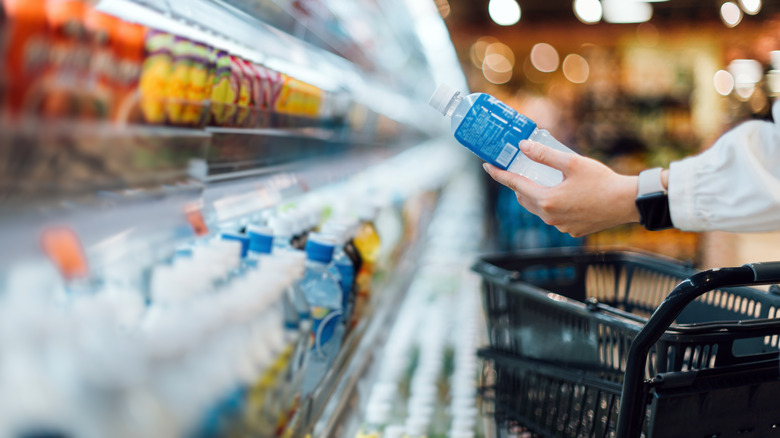You're Wasting Money If You Buy This Beverage At The Grocery Store
We may receive a commission on purchases made from links.
When you consider how much the average American spends on groceries each month, it becomes a good move to search for cheaper alternatives to some everyday items. Take bottled water, for instance; it costs much more than tap water. The EPA's WaterSense program says the average U.S. home pays about $15.21 for 1,000 gallons of water and sewer service. That comes to about 1.5 cents per gallon from the tap. Meanwhile, a single 16.9-ounce bottle of water at $1.00 costs about $7.57 per gallon. If the bottle costs $2.00, that is $15.15 per gallon, close to 1,000 times more than tap water. Even a bulk pack at Walmart, like a 32-pack of 16.9-ounce bottles for $5.97, comes out to $1.41 per gallon, which is still about 93 times the price of tap water. So, even the cheapest bottled water is much more expensive than drinking water from the tap.
Consumer groups warn that buying bottled water is an easy way to overspend at the grocery store. AARP's supermarket guide even starts by telling shoppers to stop buying bottled water, because it can quietly raise your already increasing grocery bill. The fix is to use a reusable bottle and fill it at home. If you do not like the taste of your tap water, use a basic pitcher filter instead of buying a new 24-pack each week. This simple switch can save you a lot over time, so make that a part of your grocery shopping strategies that save you money.
A cheaper way to drink better water
If you want to drink tap water safely, check your local water-quality report. Every community water system must send a Consumer Confidence Report (CCR) to households by July 1 each year. This report shows where your water comes from, what contaminants have been found, and how those results compare with federal safety limits. Use EPA's online CCR search tool or visit your local utility's website to find your CCR, then use it to decide what kind of filter, if any, you need. For example, if the report shows issues with chlorine taste or odor, lead, or PFAS, you can pick a filter that targets those specific problems.
The National Sanitation Foundation (NSF) suggests choosing filter technology by what you want to remove; NSF/ANSI 42 is for taste and odor (like chlorine), 53 targets health risks such as lead, 58 is for reverse osmosis, and 401 handles new contaminants like some medicines. Most pitcher filters cost about $30 to $35, plus extra for new cartridges. Go for faucet-mounted filters that can remove more, including lead, with a modest upfront cost, plus about $36 to $86 per year for replacement filters. Even if you spend all this, you still pay much less than if you buy cases of bottled water every week. At the same time, using a filter cuts down on plastic waste, so that's another thing to factor in .

